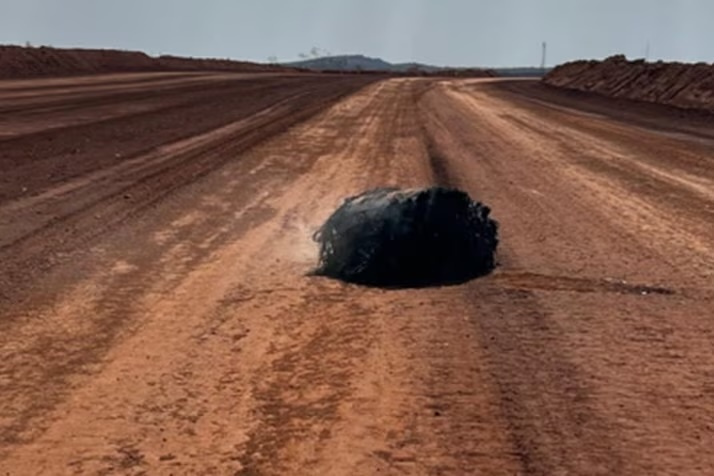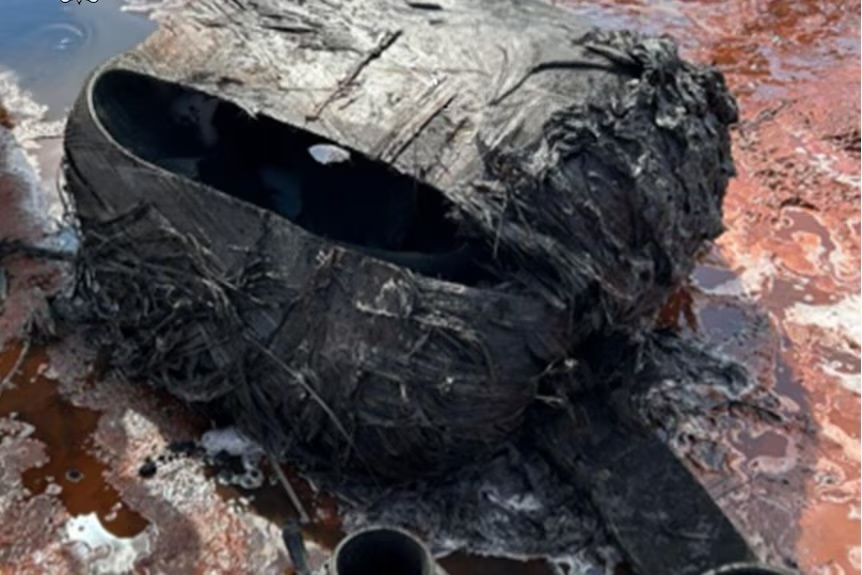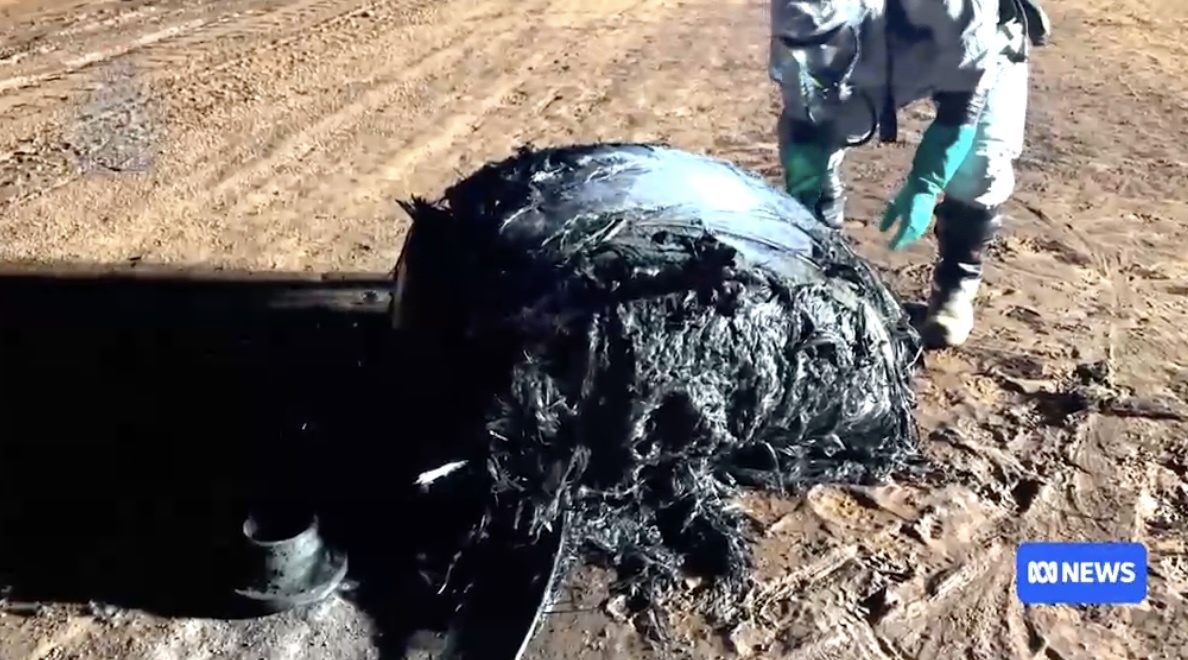19.10.2025

Suspected space debris was discovered at a mine site, approximately 30 kilometres east of Newman.(Supplied: WA Police )
Suspected space debris is believed to have crashed near a WA mine site, with the Australian Transport Safety Bureau confirming the object was not from a commercial aircraft.
WA Police were co-ordinating a "multi-agency response" after the burning object was found about 30 kilometres east of Newman in the Pilbara region.
About 2:00pm on Saturday, mine workers found the object burning near a remote access road and alerted emergency services.
Initial assessments suggested the item was made of carbon fibre.
Police said it may be "a composite-overwrapped pressure vessel or rocket tank", consistent with "aerospace components".
"In consultation with the Australian Transport Safety Bureau (ATSB), the object has been ruled out as originating from a commercial aircraft," police said in a statement.
Police said the item had characteristics of space re-entry debris.
"Further technical assessment will be undertaken by engineers from the Australian Space Agency to assist in identifying its nature and source," the statement said.

The suspected space junk. (Supplied: WA Police )
Police said they were working with the Australian Space Agency, the Department of Fire and Emergency Services and the mine operator.
"The object has been secured, and there is no current threat to public safety," police said.

The item is believed to be made of carbon fibre. (Supplied: WA Police )
Quelle: ABC NEWS
----
Update: 21.10.2025
.
Space debris found on fire near WA mining town suspected to be from Chinese rocket
Burning object made of carbon fibre discovered on desert road near mine site close to Newman on Saturday
Burning space debris that crashed to Earth in outback Australia is likely part of a Chinese rocket that launched in September, according to leading space archaeologist Alice Gorman.
Authorities are investigating the hunk of metal and carbon fibre after miners spotted it near Newman, Western Australia on Saturday afternoon.
“It seems to be the fourth stage of a Jielong rocket,” Gorman, a Flinders University associate professor and author of Dr Space Junk vs the Universe, said.
“There was one launched in late September. If it is the one from the 25th, that means it’s been orbiting the Earth for a bit and then came out of the blue.
“There was no indication it was going to re-enter right now so people weren’t expecting it – when I went to look for re-entry predictions I couldn’t find anything, which is an indication of the suddenness of it.”
WA police are leading the investigation.
“Initial assessments indicate the item was made of carbon fibre and may be a composite over-wrapped pressure vessel or rocket tank, consistent with aerospace components,” a police spokesperson said.
“The object remains under investigation, though its characteristics are consistent with known space re-entry debris … further technical assessment will be undertaken by engineers from the Australian Space Agency to assist in identifying its nature and source.”
Mine site personnel found the burning object near a remote access road and called emergency services about 2pm, police said.
Police, the Australian Space Agency, the WA Department of Fire and Emergency Services and the mine operators are all involved in the investigation.
The director general of the European Space Agency (Esa), Dr Josef Aschbacher, was in Australia recently for the International Astronautical Congress. He told Guardian Australia that space junk was becoming more of an issue in orbit and in terms of it de-orbiting and hitting land as increasing numbers of rockets are launched.

Initial assessments indicate the item was made of carbon fibre, police said, and may be a composite-overwrapped pressure vessel or rocket tank, consistent with aerospace components.Photograph: Western Australia Police Force
The Esa has created a zero debris charter.
“The signatories to this charter promise or commit themselves to take the spacecraft out of the orbit at the end of their life,” he said. “This requires some technical changes or modifications.
“First, you need to have enough fuel to de-orbit … secondly, the spacecraft needs to be designed in a way that it breaks up in small enough pieces that are then burning up in the atmosphere and are not reaching the surface.”
Gorman said everyone launching rockets should have an “end-of-life plan”.
“They might be controlled [re-entries] … where they are directed to Point Nemo, the spacecraft graveyard,” she said, which might cause environmental concerns but protected property and people.
Uncontrolled entries should be designed to burn up, she said, but fuel tanks are often made of stainless steel or titanium alloys, along with carbon fibre overlays, which give them a really high melting point.
She said it was common now for debris to land, but not so common for it to be found still burning – usually it would land far from human eyes.
Transport safety officials ruled out the item being from a commercial aircraft, saying it was more likely to be re-entering space debris.
Quelle: The Guardian
+++
Space junk found near WA mine linked to Chinese rocket launch

The moment authorities move a piece of space junk that crashed in Western Australia.
Suspected space junk that crashed near an iron ore mine in remote WA has been linked to a Chinese rocket launch, as authorities continue to probe the object's origin.
The smoking piece of debris was found on Saturday about 30 kilometres east of Newman, on a BHP mine access track.
The Australian Transport Safety Bureau and WA Police are investigating, but Flinders University space archaeologist Alice Gorman said she believed the debris was from the fourth stage of a Chinese rocket called Jielong.
Suspected space debris was discovered at a mine site about 30 kilometres east of Newman. (Supplied: WA Police)
"The last launch was late September, so this has been barrelling around the earth and quite suddenly has got pulled back to the atmosphere," Dr Gorman told ABC Radio Perth.
She said during the course of a spacecraft's orbit, it would discard several rockets and tanks which fell back to Earth in an effort to shed weight.
The burning object was found on Saturday afternoon. (Supplied: WA Police )
Dr Gorman said the planet was littered with empty rocket fuel tanks that could withstand high temperatures and did not burn up when re-entering the earth's atmosphere.
"They're so common they're called space balls," she said.
"People often find them years later. So this one's a bit unusual because it was found pretty quickly."
Origin 'not really relevant'
The Australian Space Agency (ASA) said the debris was "likely" a propellant tank or pressure vessel from a space launch vehicle.
It said it was working with global counterparts to identify the debris' exact nature and origin.
WA Police Superintendent Les Andrews said it could take weeks or months to investigate, and the debris would stay at the Pilbara mine site in the meantime.
"Once the Australian Space Agency have completed their investigations and hopefully identified an owner, through international protocol it will be arranged to be returned back to the owner," he said.
Superintendent Andrews said there was no specific nation involved at this stage, despite the speculation the debris could be linked to a Chinese rocket.
"There are thousands and thousands of satellites up in the sky in orbit … it's certainly not something that we're looking at in regards to country of origin, because there's so many of them [satellites]. It's not really relevant," he said.
A piece of space junk that washed up in Green Head two years ago is now on display in Perth. (ABC Midwest & Wheatbelt: Chris Lewis)
Two years ago, the discovery of space debris in Green Head, about 250 kilometres north of Perth, made international headlines.
The object, which the ASA said was part of an Indian rocket, was exhibited at science discovery centre Scitech in West Perth.
Is space debris dangerous?
Most debris is purposely dumped at a spacecraft graveyard known as Point Nemo — a remote stretch of the south-west Pacific Ocean.
Dr Gorman said it was likely the recent rocket discovery was what was known as an "uncontrolled re-entry".
"So nobody knew when it was coming back. They didn't know where it would come back."
WA Police say the object has been secured and there is no threat to public safety. (Supplied: WA Police)
While uncontrolled re-entries do pose a risk, the chances of space debris hitting people and property is low.
"There were two cases in America in the 70s," Perth Observatory tour administrator Matt Woods said.
Matt Woods says space junk has hit populated areas before. (ABC News: Keana Naughton)
"Someone was sleeping and the meteorite actually went through the roof and hit her on the thigh. So she had a massive big bruise.
"And then something hit the back fender of a car as well."
Another view of the space junk that crashed in WA's north. (Supplied: WA Police)
Dr Gorman said space traffic was becoming more congested, increasing the risk of space debris encroaching on civilisation.
"Qantas has had some concerns that it hasn't been getting sufficient notice of rocket launches and re-entries," she said.
"This is the world we're starting to live in, where we're having to look to the skies and be conscious of what's above us."
Who cleans up space junk?
If the rocket is found to be the property of a foreign government, Dr Gorman said it would be that government's responsibility to retrieve it.
But past events had not always played out that way.
"There was a piece of an Indian rocket that washed up on a beach [overseas]," she said.
"So the Indian government kind of said, 'It's okay, you can keep it.'
"I mean there's nothing exciting about a fuel tank but you don't know … so the space agency [might] have to engage in a government-to-government negotiation."
This object was found on a beach at Green Head in WA on July 2023. (ABC Midwest Wheatbelt: Chris Lewis)
The last high-profile piece of space junk discovered in WA was in July 2023 when a large piece of a satellite launch vehiclewashed up on a beach in Green Head.
